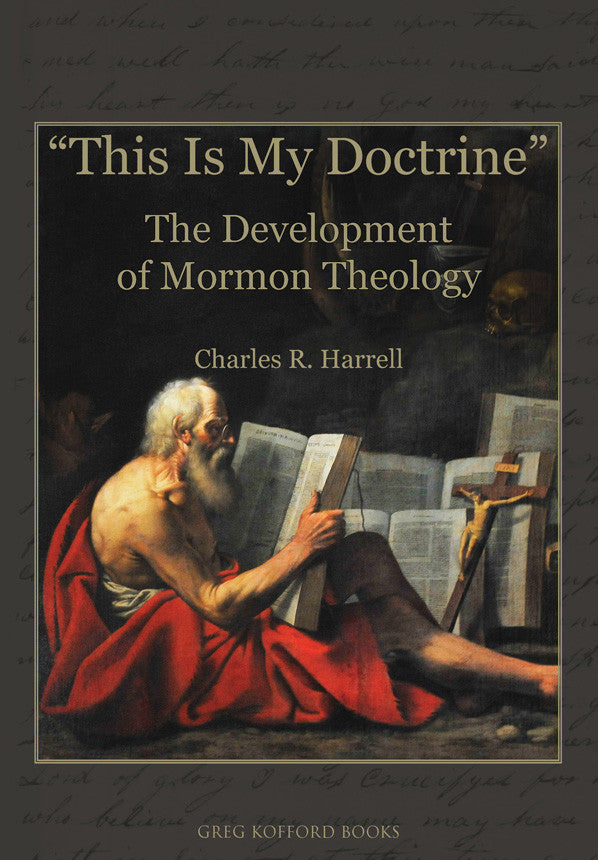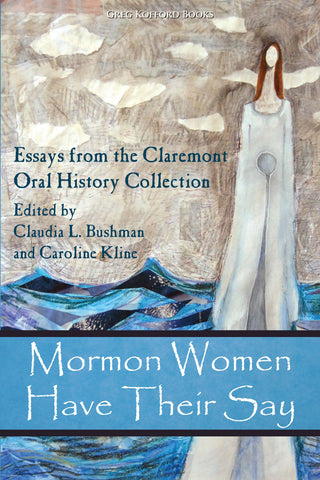“This Is My Doctrine”: The Development of Mormon Theology
$29.65
NOW IN PAPERBACK
- “More stimulating and more insightful than most other books on Mormon doctrine.... Succeeds in providing a non-apologetic yet sympathetic interpretation of Mormon doctrine, warts and all.” — James McLachlan
- “I found it fascinating enough to read straight through.” — Rational Faiths
- “This book is the real deal, and it belongs on every LDS bookshelf.” — Latter-day Detritus.



Available in ebook for Kindle, Nook, Kobo, Apple, and Google Play.
Book Description:
The principal doctrines defining Mormonism today often bear little resemblance to those it started out with in the early 1830s. This book shows that these doctrines did not originate in a vacuum but were rather prompted and informed by the religious culture from which Mormonism arose. Early Mormons, like their early Christian and even earlier Israelite predecessors, brought with them their own varied culturally conditioned theological presuppositions (a process of convergence) and only later acquired a more distinctive theological outlook (a process of differentiation).
In this first-of-its-kind comprehensive treatment of the development of Mormon theology, Charles Harrell traces the history of Latter-day Saint doctrines from the times of the Old Testament to the present. He describes how Mormonism has carried on the tradition of the biblical authors, early Christians, and later Protestants in reinterpreting scripture to accommodate new theological ideas while attempting to uphold the integrity and authority of the scriptures. In the process, he probes three questions: How did Mormon doctrines develop? What are the scriptural underpinnings of these doctrines? And what do critical scholars make of these same scriptures? In this enlightening study, Harrell systematically peels back the doctrinal accretions of time to provide a fresh new look at Mormon theology.
“This Is My Doctrine” will provide those already versed in Mormonism’s theological tradition with a new and richer perspective of Mormon theology. Those unacquainted with Mormonism will gain an appreciation for how Mormon theology fits into the larger Jewish and Christian theological traditions.
Comprehensive Table of Contents:
.
Preface
1. Theology, a Divine-Human Enterprise
Theological Conservatism and Liberalism
The Myth of Scriptural Inerrancy
The Myth of Doctrinal Uniformity
The Myth of Prophetic Infallibility
Proof-Texting
Mining the Theology of the Scriptures
2. The Great Apostasy
Biblical Prophecies of the Apostasy
Protestant Views
Early Mormonism
Contemporary Mormonism
3. Joseph Smith and the Restoration
The First Vision
Prophecies Concerning Joseph Smith
Dispensation of the Fulness of Times
The Restoration of All Things
4. The Restoration of the Priesthood and the Church
Restoration of the Priesthood
Establishment of the Church in the Latter Days
5. Doctrinal Truths Restored
The Coming Forth of the Book of Mormon
Restoring Biblical Truths
The Lost Legacy of Translation
6. The Godhead and Plurality of Gods
Nature of the Godhead
Plurality of Gods
Old Testament
7. God the Father
An Absolute Versus a Finite God
The Corporeal Nature of God
Has Any Mortal Seen God?
God as Elohim
God as the Father of Our Spirits
The Adam-God Doctrine
8. Jesus Christ
Jesus Christ
Jesus as Messiah
The Son of God
Only Begotten Son
Virgin Birth
The Firstborn
Son of Man
Christ as Jehovah
Christ as the Father
Christ as God of the Old Testament
9. The Holy Ghost
10. Satan
11. The Preexistence
Nature of the Soul
Preexistence of Souls
Foreordination
The War in Heaven
12. The Creation
The Genesis Creation Story
Agent and Method of Creation
Meaning of “Create”
Biological Evolution
Length of a “Day”
Plurality of Inhabited Worlds
The Spiritual Creation
First Flesh
Adam, the Son of God
Purpose of the Creation
13. The Fall and Nature of Humanity
Adam and Eve’s “Transgression”
Physical Consequences of the Fall
Physical Death
Power of Procreation
Physical Banishment
Removal of the Earth
Spiritual Consequences of the Fall
Spiritual Death
Original Guilt
Age of Accountability
The Dual Nature of Man
14. The Atonement
The Atonement in Historical Perspective
The Infinite Atonement
Retroactive Redemption
Universal Effects of the Atonement
15. The Gospel Plan
The Everlasting Gospel
The First Principles and Ordinances of the Gospel
Melchizedek Priesthood Ordination
The Temple Endowment
Eternal Marriage
Calling and Election Made Sure
Securing Children through the Sealing of Parents
Perfectionism and Rise to Godhood
The Salvation of Little Children
16. Salvation for the Dead
17. The Priesthood
Nature of the Priesthood
Blacks and the Priesthood
18. The Gathering of Israel and Establishment of Zion
Biblical Prophecies of the Gathering
Biblical Prophecies of Latter-day Missionary Work
Spiritual vs. Temporal Gathering
Lamanite Role in the Gathering
Latter-day Gathering Places
Gathering the Ten Lost Tribes
Latter-day Zion
New Jerusalem
19. The Second Coming and Millennium
Apocalyptic Literature and Millennial Expectations
Imminence of the Lord’s Coming
Spirit Poured Out on All Flesh
Millennialism
The New Heaven and Earth
20. The Resurrection
History of the Resurrection
Old Testament
Resurrection as a Process
Resurrection of All Life Forms
21. Final Judgment
Judgment Day
The Unpardonable Sin
Murderers
Epilogue
Firm—Yet Flexible—in the Faith
Having a Scriptural Leg to Stand On
The Crisis of Doctrinal Exclusivity
The Future of Mormon Theology
Beyond Theology
Bibliography
Scripture Index
Index
Praise for This Is My Doctrine:
“It has become a commonplace that trying to get a handle on Mormon theology is like trying to nail Jello to a wall. And there is a significant amount of truth to that perception. The problem is that people are expecting there to be a systematic theology, like the Catechism of the Catholic Church, which provides a definitive statement of the official theology of the church. But there is no such thing as a systematic Mormon theology. The only way to approach Mormon theology deeply and with comprehension is to consider it both developmentally and historically. And Charles Harrell’s volume does exactly that. “This Is My Doctrine”: The Development of Mormon Theology is a book I wish I had written, which is, I think, the highest praise one can give to a book.”— Kevin Barney, board member of Dialogue: A Journal of Mormon Thought and the Foundation for Apologetic Information and Research (FAIR); editor of Footnotes to the New Testament for Latter-day Saints
“Because he does not attempt to square circles by making Mormon doctrine consistent over time, Harrell’s encyclopedic survey of Mormon doctrine is more stimulating and more insightful than most other books on Mormon doctrine. He takes many of our most beloved and disputed doctrines and shows the different ways they have been understood (sometimes by the same authority) at different moments in time. What is both amazing and refreshing is that he succeeds in providing a non-apologetic yet sympathetic interpretation of Mormon doctrine, warts and all.”— James McLachlan, Professor of Philosophy and Religion at Western Carolina University; co-editor of Discourses in Mormon Theology: Philosophical and Theological Possibilities.
“This volume offers a balanced account of current biblical scholarship, outlines the development of Joseph Smith’s thinking, and, most importantly, forces a reconsideration of how revelation might be understood. Highlighting discontinuity, Harrell challenges traditional Mormon dispensationalism—replacing the view of dispensations as restatements of eternal verities, with an account where each dispensation is marked by prophets struggling to define the gospel and reach after truth. In doing so, Harrell provides fresh evidence that humanity’s understanding of the gospel is always limited and that, thus, we must necessarily live by faith.”— Graham St. John Stott, Professor, Arab American University, Jenin
“Harrell argues for the legitimacy of a dynamic and pragmatic religion that is not held captive by former dogmatic theological assertions. It embodies the principle that living "prophets" are more valuable than dead ones when it comes to expressing and understanding our dynamic religious heritage."— David Tayman, Improvement Era.
“This book is the real deal, and it belongs on every LDS bookshelf.” — Latter-day Detritus.
“Harrell’s citations will be useful for other scholars seeking to get a quick sense of the primary sources, and his thumbnail sketches–all the space, likely, which such an expansive effort allowed–raise a number of questions they might pursue.“— Matt Bowman,The Juvenile Instructor. Also appeared in the Winter 2011 Dialogue
“To many it may be a good reference book, but I found it fascinating enough to read straight through.” — Matthew Kern, Rational Faiths
Podcast Interviews:
About the Author:
 Charles R. Harrell (Ph.D., manufacturing engineering, University of Denmark) is an associate professor in Brigham Young University’s School of Technology, where he is the graduate coordinator for the manufacturing systems program. In addition to teaching and advising students, he oversees student projects aimed at improving business operations. He recently led a humanitarian project to build electricity-generating playground equipment in Ghana. He is also founder and director of ProModel Corporation, which is a leading provider of simulation software and has authored several books on the use of simulation to improve business processes. In addition to his professional activities, Charles is an ardent theological hobbyist and has published articles on Mormon theology in BYU Studies, The Encyclopedia of Mormonism, and Studies in the Scriptures. He also taught seminary and institute for many years. Charles and his wife, Yvonne, are the parents of five children and live in Orem, Utah
Charles R. Harrell (Ph.D., manufacturing engineering, University of Denmark) is an associate professor in Brigham Young University’s School of Technology, where he is the graduate coordinator for the manufacturing systems program. In addition to teaching and advising students, he oversees student projects aimed at improving business operations. He recently led a humanitarian project to build electricity-generating playground equipment in Ghana. He is also founder and director of ProModel Corporation, which is a leading provider of simulation software and has authored several books on the use of simulation to improve business processes. In addition to his professional activities, Charles is an ardent theological hobbyist and has published articles on Mormon theology in BYU Studies, The Encyclopedia of Mormonism, and Studies in the Scriptures. He also taught seminary and institute for many years. Charles and his wife, Yvonne, are the parents of five children and live in Orem, Utah
More Information:
597 pages
ISBN: 978-1-58958-506-5 (Paperback); 978-1-58958-103-6 (Hardcover - Out of Print)
Published August 2011






Share this item: